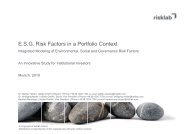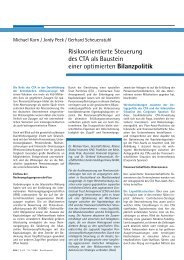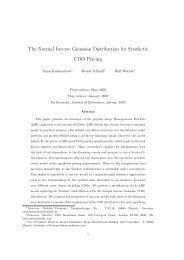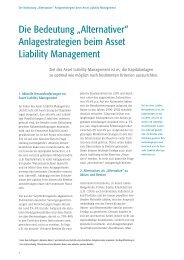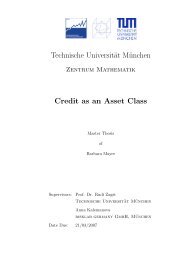Technical University Munich Commodities as an Asset Class - risklab
Technical University Munich Commodities as an Asset Class - risklab
Technical University Munich Commodities as an Asset Class - risklab
You also want an ePaper? Increase the reach of your titles
YUMPU automatically turns print PDFs into web optimized ePapers that Google loves.
1 Introduction<br />
Investing in fin<strong>an</strong>cial <strong>as</strong>sets w<strong>as</strong> for a long time <strong>an</strong> exclusive <strong>an</strong>d covered business<br />
which w<strong>as</strong> reserved to institutional <strong>an</strong>d selected wealthy investors. The introduction<br />
of the internet <strong>an</strong>d direct brokerage made tr<strong>an</strong>saction costs falling <strong>an</strong>d hence<br />
investment became available to the broad public. While the investment volume in<br />
stock <strong>an</strong>d bond markets grew steadily in America over the l<strong>as</strong>t 20 <strong>an</strong>d in Europe<br />
over the l<strong>as</strong>t 10 years,, commodities did not play a major role in fin<strong>an</strong>cial investment<br />
owing their low prices <strong>an</strong>d in-tr<strong>an</strong>sparency. But the situation h<strong>as</strong> ch<strong>an</strong>ged over the<br />
p<strong>as</strong>t 5 years. Industry h<strong>as</strong> grown to close to 9 billion traded contracts in 2005. 1<br />
Due to low perform<strong>an</strong>ce of stocks <strong>an</strong>d bonds, the time period from 2000 to 2003<br />
boosted the growth of fin<strong>an</strong>cial commodity markets in particular. The total amount<br />
of traded contracts h<strong>as</strong> nearly tripled during this time. There are two dimensions<br />
which foster the development: hedging <strong>an</strong>d investing. The former is mainly driven<br />
by structural ch<strong>an</strong>ges in the global economy <strong>an</strong>d the remarkable dem<strong>an</strong>d during the<br />
1980s <strong>an</strong>d 1990s: Certain industries lowered their resource intensity noticeably or<br />
became more efficient. This applies for inst<strong>an</strong>ce to the automobile industry which<br />
h<strong>as</strong> steadily reduced the proportion of metal in their cars. Something similar c<strong>an</strong><br />
also be noted for farm outputs which could be incre<strong>as</strong>ed considerably by me<strong>an</strong>s of<br />
technological improvements. For this re<strong>as</strong>on, producing commodities became a less<br />
attractive <strong>an</strong>d low profit business. This development led, however, to a decre<strong>as</strong>e in<br />
production <strong>an</strong>d falling inventories. After the collapse of the communist system, approximately<br />
three billion people, accounting for almost 70% of world’s population,<br />
entered into global trade. Their cheap labor costs attracted low educational work of<br />
the producing business or IT-services of international acting comp<strong>an</strong>ies. This way<br />
of proceeding boosted their economic growth <strong>an</strong>d hence the need for more energy,<br />
new infr<strong>as</strong>tructure, diversified food <strong>an</strong>d thus, for commodities. Caused by the recession<br />
in the commodity producing industry during the 1980s, the business w<strong>as</strong> not<br />
prepared for the sudden dem<strong>an</strong>d <strong>an</strong>d prices went through the roof. This forced comp<strong>an</strong>ies<br />
to focus on commodity price risk m<strong>an</strong>agement what fuelled the dem<strong>an</strong>d for<br />
fin<strong>an</strong>cial risk hedging products. On the other h<strong>an</strong>d, the low perform<strong>an</strong>ce of stocks<br />
<strong>an</strong>d bonds between 2000 <strong>an</strong>d 2003 moved investors to look around for new, more<br />
attractive return sources. Rising prices of commodities since 2001, have stimulated<br />
their interest <strong>an</strong>d thereupon, the dem<strong>an</strong>d for products to enable investment in this<br />
market.<br />
On the following pages, we introduce commodity markets from the investment’s<br />
1 See Futures Industry Magazine J<strong>an</strong>/Feb 2006, Figure includes contracts on fin<strong>an</strong>cial <strong>as</strong>sets.<br />
1



